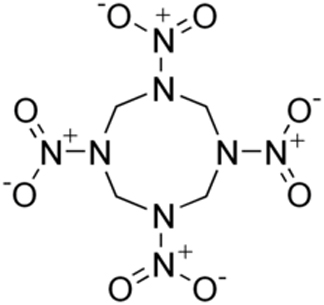 What is HMX?
What is HMX?
HMX (Octogen) is an acronym for High Melting eXplosive. It is also known as octogen and cyclotetramethylene-tetranitramine, as well as by other names. It is a colorless solid that dissolves slightly in water. Only a small amount of HMX (Octogen) will evaporate into the air; however, it can occur in air attached to suspended particles or dust. The taste and smell of HMX (Octogen) are not known. HMX (Octogen) does not occur naturally in the environment.
Uses
HMX is used in nuclear devices, plastic explosives, rocket fuels, and burster chargers. A small amount of HMX is also formed in making cyclotrimethylene-trinitramine (RDX), another explosive similar in structure to HMX. The amount of HMX made and used in the United States at present is not known, but it is believed to be greater than 30 million pounds per year.
Sources & Potential Exposure
Most of the HMX that enters the environment is released into waste water from places that make or use HMX. A small amount of HMX can be released to the air as dust or ash from facilities that burn waste contaminated with HMX. Some HMX may be released to soil as a result of accidental spills, the settling of HMX-containing dust particles from the air, or the disposal of waste that contains HMX in landfills.Laboratory studies show that HMX is likely to move from soil into groundwater, particularly in sandy soils. For most soils, however, the movement of HMX into groundwater is expected to be slow. Bacteria in the soil are not expected to break down HMX to any large extent. Exactly how long HMX will remain in the environment is not known; however, HMX in soil and groundwater is expected to stay there for a long time. It is not known if plants, fish, or animals living in areas contaminated with HMX build up high levels of the chemical in their tissues.
Federal Regulations
EPA: Not classifiable as to human carcinogenicity. IARC: Not evaluated. NTP: Not evaluated

 Americas
Americas Europe
Europe Français
Français Deutsch
Deutsch Italiano
Italiano Español
Español


